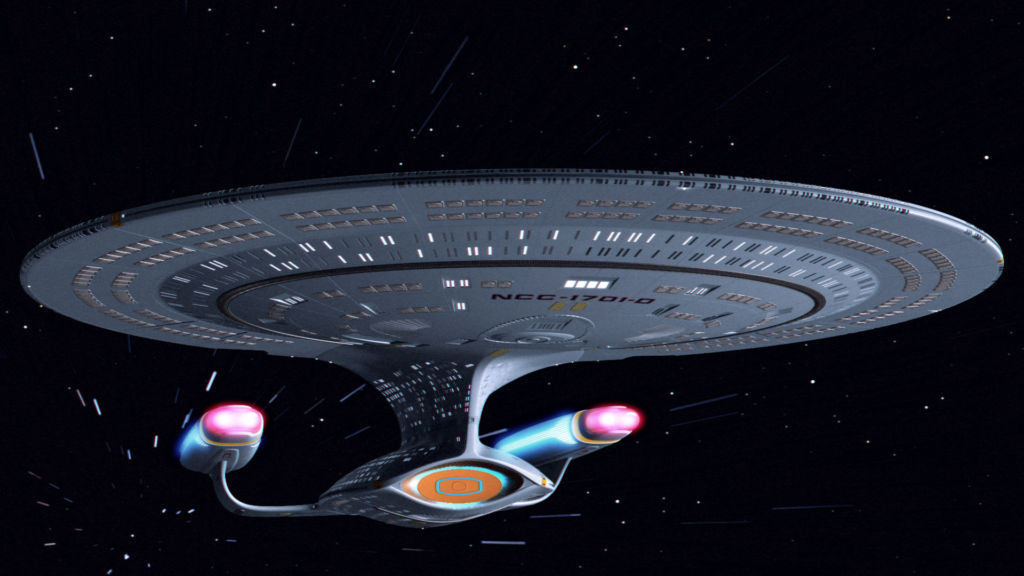From Star Wars to Star Trek, the idea of interstellar travel has always fascinated us. Today, scientists and researchers are looking for ways to turn the vision of interstellar travel into reality. One of the key components of interstellar travel is finding an effective and efficient propulsion system. For such travel, scientists have proposed a method of spacecraft propulsion by using radiation pressure exerted by sunlight on large mirrors. This method is known as Solar Sail propulsion. A better, alternative, approach that researchers have recently been looking at is using high energy laser beams as a source of radiation pressure for propulsion. This method is known as photon sailing. The main idea behind these approaches is to obtain a near infinite source of force to accelerate crafts close to the speed of light, making interstellar travel possible.

An image of the U.S.S. Enterprise from the 1973-74 Star Trek show. The craft here can here be seen accelerating near the speed of light (warp speed) for interstellar travel. TV shows like this one inspires us to find ways to make interstellar travel possible.
History
While looking at the night sky, Johannes Kepler observed that comet tails point away from the sun, theorizing that the effect was caused by the sun. In a letter to Galileo, he wrote, “Provide ships or sails adapted to the heavenly breezes, and there will be some who will brave even that void”. The idea that solar pressure can be used to accelerate aircrafts goes back to the concept of light pressure. In 1861 – 1864, James Maxwell published his theory of electromagnetic fields and radiation, which proved that light has momentum and can exert pressure. Soon after, in 1899 a Russian physicist, Pyotr Lebedev was the first to use a torsional balance to successfully demonstrate that light does indeed exert pressure on solid surfaces.
This theory led to the foundation that light pressure can be used for cosmic sailing. In 1908, Svante Arrhenius predicted that light could essentially move objects in the interstellar space. In 1925, Friedrich Zander published a technical paper that included details of solar sailing. He implied that applying a series of small forces by utilizing solar pressure or transmission of light energy to very thin mirrors would allow interstellar travel.

An artist’s depiction of how the rays of the sun can be used as a source of energy to propel a craft. In particular, the photons that hit the large mirrors of the craft can provide enough force for acceleration.
Electric Solar Wind Sail
Pekka Janhunen from Finnish Meteorological Institute (FMI) invented a type of solar sail called the electric solar wind sail. Even though the mechanics of this sail have little in common with the traditional solar sail, its function is similar which is to propel the aircraft near the speed of light. Mechanically speaking, the sails are replaced with straightened conducting tethers (wires) that are placed radially around the host ship. Electric field is created around the ship because the wires are electrically charged. The field acts like a mirror that reflects the solar electrons, propelling the ship. This ship is quite lighter when compared to the solar sails because the radius of the sail is dictated entirely by the electric field, not the wires themselves. A conceptual design of this aircraft will involve 50 – 100 straightened wires with a length of about 20 km each.
Magnetic Sail
Another type of sail that employs solar wind for acceleration is called the Magnetic Sail. In this design, the magnetic field is used to deflect the electrically charged particles in the wind. The mechanism involves using wire loops and running a static current through them instead of applying a static voltage. This type of sail is also very good in regards of maneuvering. In particular, magnetic sails follow the path of the charged protons. Therefore, the amount and direction of the thrust can be changed by altering the sails’ altitudes and the size of the magnetic fields.
Maneuvers during Interstellar Travel
Operating sails is most convenient when traveling through interplanetary space, because maneuvering them (changing directions) is easier when done at low speeds. However, it is essential to design a craft that can be maneuvered at high speeds, because only then the crafts can be used for interstellar travel. Our current technology only allows us to operate sails at low speeds partly because changing their directions and estimating their approach angles is not yet possible at high speeds even well before we reach the relativistic limits. For example, trajectory optimizations can often require intervals of reduced or zero thrust, which can only be accomplished if the speed of the craft is relatively low.
Summary
In this article, we went over various craft designs that use the pressure exerted by photons and electric/magnetic fields for acceleration. The idea behind making such designs is to accomplish the dream of interstellar travel. Unfortunately, the conceptual designs of such vehicles cannot yet be constructed into functioning crafts yet. While the state of technological advances are not yet enough to make such a prototype, we could see a day where we approach a long-distant travel with out-of-the box thinking in terms of both the design and the implementation.
Further Reading
- Magnetic Sails – Wikipedia, https://en.wikipedia.org/wiki/Magnetic_sail
- Solar Sail – Wikipedia, https://en.wikipedia.org/wiki/Solar_sail
- Electric Sail – Wikipedia, https://en.wikipedia.org/wiki/Electric_sail
